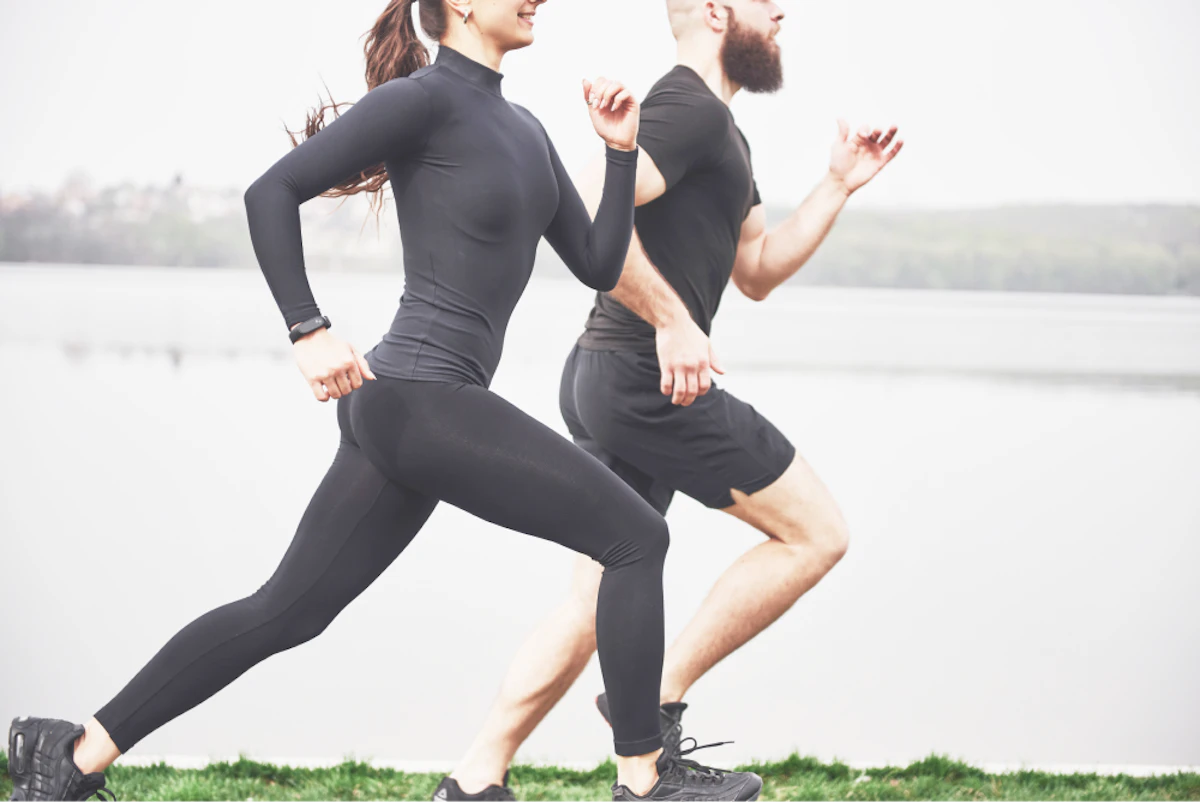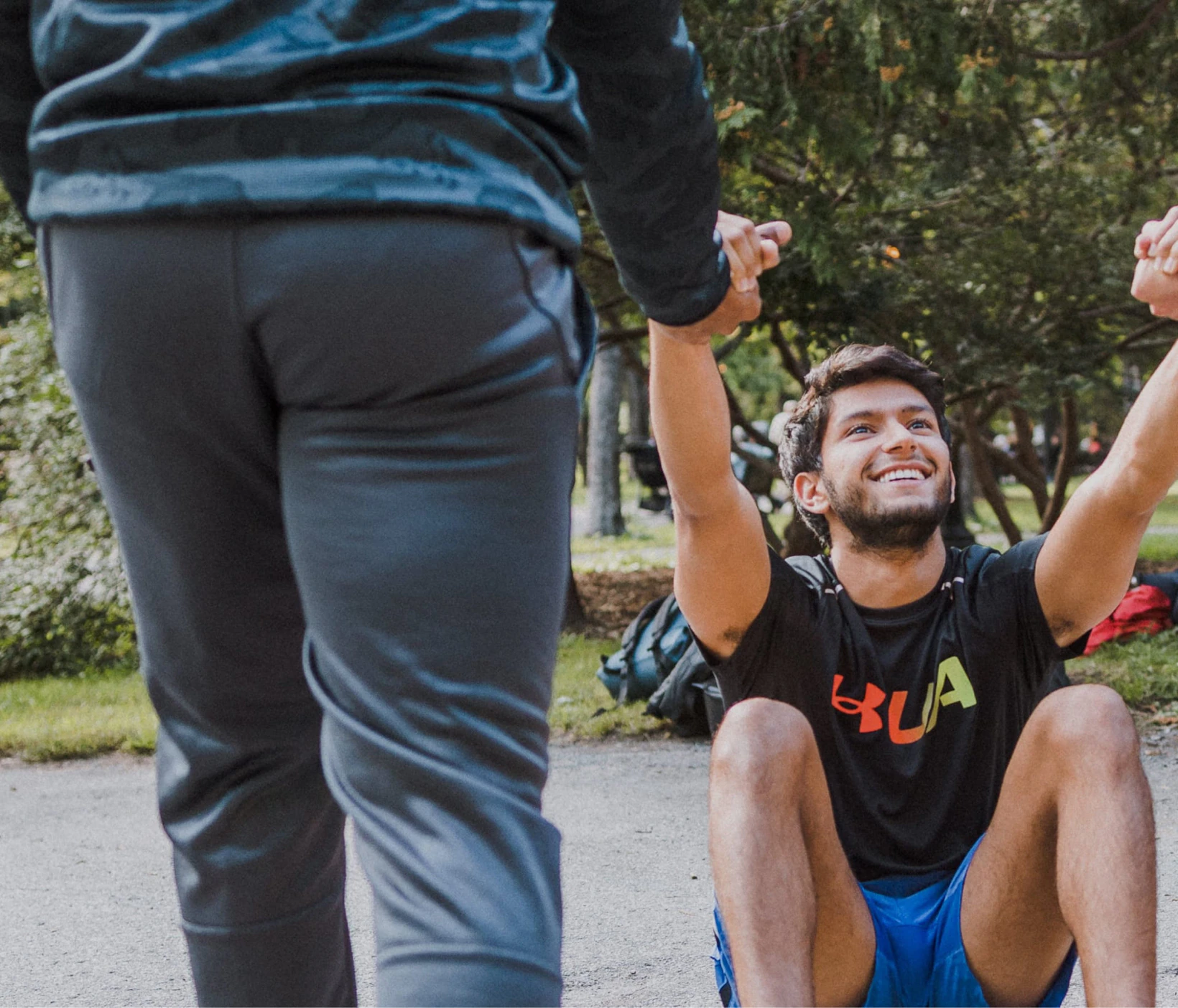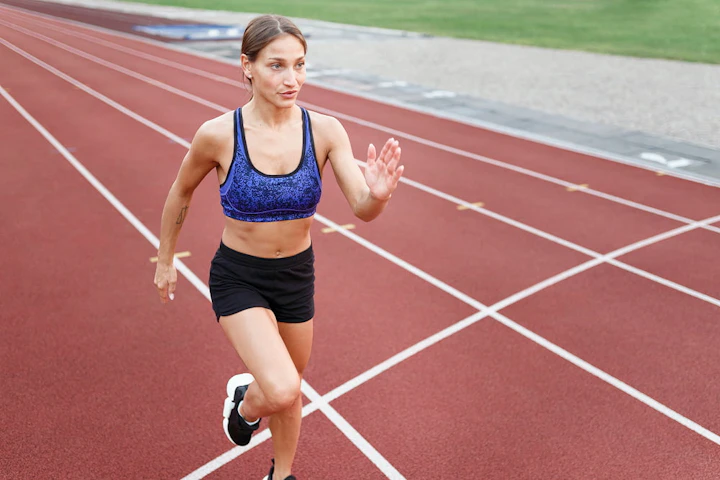The keys to maintaining the good pace of run

18 min read
Summary
Definition of pace in running (in min/km and in km/h)
Calculating pace in min/km from speed in km/h, and vice versa
Pace table based on target time for mythical distances (5 km, 10 km, half marathon, marathon, 100 km)
Pace table based on world records (5 km, 10 km, half marathon, marathon, 100 km)
Pace table based on speed
What is a good pace of run/a good rhythm for running?
🤔 Is 10 km in 1 hour good?
🙈 Is 5 km in 30 minutes good?
Tips to maintain the right pace during a race
🎯 Clearly define your performance goals to ensure or maintain your progress... and therefore your motivation!
👌 Train by effort zones during training (notably easy runs in zone 2 = base endurance) and learn to decode your sensations and heart rate
🗒️ Adopt a structured training plan (intervals, endurance, MAS, etc.)
🏃♀️ Train at target pace (see the famous test session)
🔎 Improve your cadence to optimize your pace

Receive advice from our passionate coaches!
Maintaining the right pace of run is one of the major challenges, not to say THE quintessential challenge for novice or experienced runners. How many times have you burned out at the start of a race only to cross the finish line exhausted? On the contrary, you may have already felt that you didn't give your best... Also, understanding and mastering your pace is, in our opinion, the key to optimizing your performance and getting maximum enjoyment during the effort, while avoiding unnecessary fatigue and post-race disappointment. In this article, we break down this essential concept together: from the precise definition of pace to its calculation, including reference tables and practical tips, we help you define your ideal rhythm based on your goals... and maintain it throughout your training and competitions! Prepare to run with your legs AND your head. 🧠
Definition of pace in running (in min/km and in km/h)
Understanding the concept of pace is fundamental for any runner seeking to improve their times. Unlike speed, expressed in kilometers per hour (km/h), pace is defined in minutes per kilometer (min/km). This specificity allows you to visualize the time needed to cover each kilometer more intuitively, in addition to being more meaningful for athletes who run with smartwatches. For example, a pace of 6 min/km means it takes you 6 minutes to cover one kilometer, while a speed of 10 km/h indicates the distance covered in one hour (a pace of 6 min/km is equivalent to a speed of 10 km/h). This distinction is very useful for refining your perception as well as for planning your training! 🙌
Calculating pace in min/km from speed in km/h, and vice versa
The conversion between pace (min/km) and speed (km/h) is simple and allows you to easily switch between the two metrics to better understand your optimal pace in running. To convert a speed from km/h to pace in min/km, simply divide 60 by the speed in km/h. For example, if you run at 12 km/h, your pace will be 60 / 12, which is 5 min/km. Conversely, to switch from pace to speed, divide 60 by your pace. Thus, a pace of 4 min/km corresponds to a running speed of 60 / 4 = 15 km/h. 🤓

Pace table based on target time for mythical distances (5 km, 10 km, half marathon, marathon, 100 km)
Here is a summary table of average paces to adhere to for achieving specific times in the most popular race formats.
⚠️ These figures are indicators and may vary considerably depending on each individual's level. It is essential to consider them as benchmarks for planning your training sessions and competitions, not as absolute targets.

Access the survey results
Pace table based on world records (5 km, 10 km, half marathon, marathon, 100 km)
Although these figures may seem unattainable for the majority of runners, they provide a fascinating perspective on the highest global level. Here are the running paces adopted by the male and female runners who have set the current world records on the road (in mixed races).
Pace table based on speed
This table is intended to help you better visualize the correspondence between pace in min/km and speed in km/h.
What is a good pace of run/a good rhythm for running?
A good pace of run is above all a pace that is adapted to your sports goals and your current physical condition, but also one that you can legitimately aim for following the training you have done. There is no "one good pace" per se, nor a universal rhythm that one should follow to be considered a true runner. Your good pace of run — over a specific distance and at a specific time in your life — is the result of a balance between, notably, your preparation for the event in question, your feelings on race day, and your ability to maintain your pace for the desired duration. Furthermore, a good pace of run also depends on the type of training performed: while for a recovery run, it is a pace at which you can talk without being out of breath; for a competition, the good pace at which you can run if you wish to perform is the fastest rhythm you can maintain without collapsing before the finish. Your good pace of run is therefore a combination of feelings, experience, targeted training, and goals that will allow you to find and maintain your optimal rhythm.

🤔 Is 10 km in 1 hour good?
If the title of this paragraph caught your attention, there is a good chance that you are looking to validate your sports performances. Obviously, no matter how long it takes you to complete the 10-kilometer distance, and no matter how many kilometers you cover, the essential thing is to move (even if the sport you have chosen is not running 🙈) and to enjoy it! So if you are not (yet) able to run at 10 km/h, don't worry: it's not an end in itself. Nothing should diminish the happiness you feel when you run... especially not a time record!
And to answer the question you are asking yourself, whether running 10 kilometers in one hour is good? The answer is (not surprisingly): absolutely! Running 10 km in 1 hour, at a pace of 6 min/km (and therefore an average speed of 10 km/h) is a commendable performance. This pace demonstrates a solid endurance and a capacity to maintain a sustained effort over a significant and, moreover, symbolic distance (since you then surpass the ten-kilometer mark while flirting with the one-hour barrier). Moreover, if this time is often a goal for many runners, it is because it marks an important milestone in their progress. So slowly but surely get closer to this milestone if you wish to reach it, and if you couldn't care less: bless you! 👑
🙈 Is 5 km in 30 minutes good?
Ah, the love of round numbers almost makes us forget that the essential thing is not the time displayed on our watch, but to appreciate the act of running or just being outdoors! Obviously, completing 5 kilometers in 30 minutes (at an average pace of 6 min/km) is a very respectable goal. For many runners, crossing the 30-minute barrier on 5 kilometers is a significant and motivating victory, and an opportunity to prove to themselves that they are capable of maintaining a rhythmic effort (10 km/h) over this distance... opening the door to future progressions!
Tips to maintain the right pace during a race
Maintaining a good pace of run throughout a training session or a competition is an art that is acquired through practice... and the implementation of some key strategies. The management of rhythm is crucial to avoid premature exhaustion or, conversely, the feeling of having too much left in the tank (which is however very encouraging!). With these tips, we hope you can refine your perception and use the tools at your disposal to run smarter and achieve your goals.
🎯 Clearly define your performance goals to ensure or maintain your progress... and therefore your motivation!
Before thinking about the pace to adopt, it is imperative to set clear and realistic goals. Do you want to be a finisher (no matter the time at the finish) or improve your personal record? Once your goal is defined, you can establish your good pace in running. At Campus, we have set up a pace calculator to predict the time you can aim for based on your past performances.
💡Achievable goals are defined based on several elements:
👉 your base level;
👉 the time you are able to allocate to your training;
👉 the duration of your preparation;
👉 and the entirety of the training provided (respecting session paces, low absenteeism rate, absence of injury, optimized recovery protocols and lifestyle: nutrition, sleep, stretching and mobility, massage, etc.).

👌 Train by effort zones during training (notably easy runs in zone 2 = base endurance) and learn to decode your sensations and heart rate
Effort zone table to determine your RPE 🔥
| Pace | Associated Perceived Effort Rating | Perceived Effort | % of Max HR |
|---|---|---|---|
Easy Endurance | 1-2 | Very easy (very slow pace / leisurely) | <70 % |
Fundamental endurance (FE) | 2-3 | Easy (slow and comfortable pace) | 70-77 % |
Active Endurance (AE) | 4-5 | Moderate (moderate pace / active / mild engagement) | 77-85 % |
60' Threshold / Sweet spot | 6-7 | Comfortably difficult (steady pace) | 85-92 % |
30' Threshold | 8 | Hard (high intensity) | 90-95 % |
V02 Max | 9 | Very hard (very high intensity) | 90-100 % |
Sprint | 10 | Maximum speed (maximum intensity) | / |
Training by effort zones is a pillar for progressing well! Each zone corresponds to your own pace that you can define based on your heart rate and your sensations. Knowing your sensations will allow you to differentiate these zones and adapt your pace in real-time, even without a watch, to run more intuitively and efficiently.
Easy runs in zone 2 (corresponding to base endurance) are essential because running at a low intensity — in other words, at a pace where you can talk without being out of breath — allows you to strengthen your cardiovascular system without excessive fatigue, become more enduring, and most importantly, actively recover from your past more intense efforts (interval training, etc.).
🗒️ Adopt a structured training plan (intervals, endurance, MAS, etc.)
It's not us who will tell you otherwise: a structured training plan is essential to progress and find your good pace of run over different distances. An effective training program is by definition adapted to your needs and constraints, but also (as much as possible) adapted to your goals. It is both varied and progressive, and above all, it encourages you to run regularly. It consists of various sessions:
the interval training allows you to improve your speed on varied intervals and optimize your ability to sustain high rhythms;
the base endurance runs develop your endurance;
VMA (Maximum Aerobic Speed) training increases your speed potential;
etc..
🏃♀️ Train at target pace (see the famous test session)
To be able to maintain your good pace of run on race day, it is crucial to train specifically and regularly. Test sessions — also known as specific pace sessions — are trainings during which you cover segments of the race more or less long at the pace you aim for in your competition. Thanks to these sessions, you imprint your running rhythm in your legs and your mind, learn to manage your effort and fatigue, and are confronted with concrete benchmarks. In short, you have understood it: these sessions are essential to assess your ability to maintain the desired pace and, if necessary, to adjust your goals. Finally, each test session is an opportunity to reinforce your confidence in your ability to sustain your target pace.
🔎 Improve your cadence to optimize your pace
Cadence (number of steps per minute) is a parameter that can optimize your good pace of run. A higher cadence (around 170-180 steps/minute) is generally associated with a more efficient and less stressful stride for the joints, as it reduces ground impact time. Working on increasing your cadence can improve your running economy and allow you to maintain your pace more easily. Of course, it is essential to remain attentive to your sensations and to proceed gradually... you must be comfortable!
Mastering your pace of run is essential if you want to hit your goals and cross the finish line satisfied. Whether you use a pace calculator or rely on long runs and tempo runs in your training plan, knowing your average pace helps you set realistic expectations for a 5K race, half, or even full marathon. A few 20 minutes or 30 minutes time-based efforts at goal or threshold pace can reveal your ideal pace, helping you project your finish time and keep your confidence high.
Learning to measure your race pace and marathon pace isn’t just about numbers—it’s about how you feel. Monitoring heart rate, paying attention to breath and fatigue, and comparing what feels good vs what’s too fast all matter. On race day, remembering those sensations from training lets you regulate effort so you don’t burn out early—or leave too much in reserve.
If you want to predict your race time well, start by determining your 5K pace or doing a test at threshold, then build from there. Use long runs to build endurance, tempo runs to teach your legs and lungs what working hard should feel like, and steady easy pace runs for recovery. Together, these will allow you to run smart, feel good, and hit your goal time across different distances—be it 5K, 10K, half-marathon, or marathon pace.
By combining measurable metrics with intuitive awareness, you’ll arrive at a balanced approach. Use your tools—pace calculators, average pace from time-based workouts, heart rate monitoring—alongside your body’s feedback. Do that, and you won’t just cross the line—you’ll do so knowing you ran your race with strategy, strength, and purpose.
Beyond the raw numbers in min/km, finding and mastering your good pace in running (over a specific distance and following quality training) is above all a matter of deep connection to your sensations and goals. By clearly defining your ambitions, adopting a structured training plan, varying your training by effort zones, getting accustomed to your target pace, and paying attention to parameters such as your cadence or running technique, you will be able to run smarter, more efficiently, and achieve your goals.
So, lace up your sneakers and discover your own pace of run, the one that will lead you to pleasure and/or performance! 🚀









